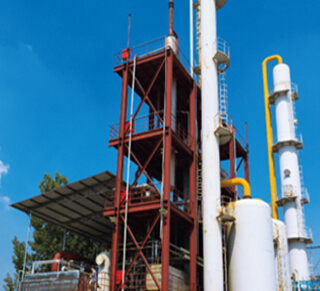幹法脫硫是一種簡易、高效、低成本的脫硫方式,一般適合用於(yu) 沼氣量小,硫化氫濃度低的沼氣脫硫。幹法脫除沼氣氣體(ti) 中硫化氫(H2S)的設備基本原理是以O2使H2S 氧化成硫或硫氧化物的一種方法,也可稱為(wei) 幹式氧化法。幹法設備的構成是,在一個(ge) 容器內(nei) 放入填料,填料層有活性炭、氧化鐵等。氣體(ti) 以低流速從(cong) 一端經過容器內(nei) 填料層,硫化氫(H2S)氧化成硫或硫氧化物後,餘(yu) 留在填料層中,淨化後氣體(ti) 從(cong) 容器另一端排出。
Dry desulfurization is a simple, efficient, and low-cost desulfurization method that is generally suitable for biogas desulfurization with small biogas volume and low hydrogen sulfide concentration. The basic principle of the equipment for dry removal of hydrogen sulfide (H2S) from biogas gas is a method of using O2 to oxidize H2S into sulfur or sulfur oxides, also known as dry oxidation method. The composition of dry process equipment is to place fillers in a container, with a filler layer consisting of activated carbon, iron oxide, etc. The gas passes through the packing layer inside the container at a low flow rate, and hydrogen sulfide (H2S) is oxidized to sulfur or sulfur oxides, remaining in the packing layer. After purification, the gas is discharged from the other end of the container.
幹式脫硫主要包括主體(ti) 鋼結構、脫硫劑填料、觀察窗、壓力表、溫度表等組件。脫硫塔通常設計為(wei) 一用一備,交替使用,即一個(ge) 脫硫,一個(ge) 再生。 含有硫化氫(H2S)的沼氣進入脫硫塔底部,在穿過脫硫填料層到達頂端的過程中,H2S與(yu) 脫硫劑發生以下的化學反應:

Dry desulfurization mainly includes components such as the main steel structure, desulfurizer filler, observation window, pressure gauge, temperature gauge, etc. Desulfurization towers are usually designed as one for use and one for backup, with alternating use, i.e. one for desulfurization and one for regeneration. The biogas containing hydrogen sulfide (H2S) enters the bottom of the desulfurization tower and undergoes the following chemical reactions with the desulfurization agent during the process of passing through the desulfurization filler layer and reaching the top:
步: Fe2O3 · H2O + 3 H2S = Fe2S3 + 4 H2O (脫硫)
Step 1: Fe2O3 · H2O+3 H2S=Fe2S3+4 H2O (desulfurization)
第二步: Fe2S3 + 3/2 O2 + 3 H2O = Fe2O3 · H2O + 2 H2O + 3 S(再生)
Step 2: Fe2S3+3/2 O2+3 H2O=Fe2O3 · H2O+2 H2O+3 S (regeneration)
含有硫化氫的沼氣首先與(yu) 底部入口處荷載相對高的脫硫劑反應,反應器上部是負載低的脫硫劑層,通過設計良好的沼氣空速和線速,幹式脫硫能到達良好的精脫硫效果。
The biogas containing hydrogen sulfide first reacts with a desulfurization agent with a relatively high load at the bottom inlet. The upper part of the reactor is a desulfurization agent layer with a low load. By designing a good biogas airspeed and line speed, dry desulfurization can achieve good precision desulfurization effect.
在沼氣進入幹式脫硫塔之前,應設置有冷凝水罐或沼氣顆粒過濾器。該裝置可以消除沼氣中夾雜的顆粒雜質,並使得沼氣在進入脫硫前含有一定濕度。
Before biogas enters the dry desulfurization tower, a condensate tank or biogas particle filter should be installed. This device can eliminate particle impurities mixed in biogas and make biogas contain a certain amount of humidity before entering desulfurization.
當觀察到脫硫劑變色,或係統壓力損失過大時,應交替使用另一個(ge) 脫硫塔。當前的脫硫塔在沼氣放空後,進行自然通風,對脫硫劑進行再生。當再生效果不佳時,應從(cong) 塔體(ti) 底部將廢棄的脫硫劑排除,在底部排放廢棄填料的同時,相同體(ti) 積的新鮮脫硫填料加入反應器中。
When discoloration of the desulfurization agent or excessive pressure loss in the system is observed, another desulfurization tower should be used alternately. The current desulfurization tower undergoes natural ventilation and regeneration of the desulfurization agent after the biogas is vented. When the regeneration effect is poor, the waste desulfurizer should be discharged from the bottom of the tower body. At the same time as the waste filler is discharged from the bottom, fresh desulfurized filler of the same volume should be added to the reactor.
This article is provided by China Biogas Desulfurization Co., Ltd. Our website is: https://www.echo-vortex.com We will provide you with wholehearted enthusiasm and welcome your visit!
 首頁- betway体育入口 > 公司新聞
首頁- betway体育入口 > 公司新聞
 2023-11-09
2023-11-09
